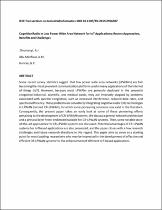 ResearchSpace
ResearchSpace
Cognitive radio in low power wide area network for IoT applications: Recent approaches, benefits and challenges
JavaScript is disabled for your browser. Some features of this site may not work without it.
- ResearchSpace
- →
- Research Publications/Outputs
- →
- Journal Articles
- →
- View Item
| dc.contributor.author |
Onumanyi, Adeiza J

|
|
| dc.contributor.author |
Abu-Mahfouz, Adnan MI

|
|
| dc.contributor.author |
Hancke, GP

|
|
| dc.date.accessioned | 2020-04-09T09:38:10Z | |
| dc.date.available | 2020-04-09T09:38:10Z | |
| dc.date.issued | 2019-11 | |
| dc.identifier.citation | Onumanyi, A.J., Abu-Mahfouz, A.M.I. and Hancke, G.P. 2019. Cognitive radio in low power wide area network for IoT applications: Recent approaches, benefits and challenges. IEEE Transactions on Industrial Informatics: DOI: 10.1109/TII.2019.2956507 | en_US |
| dc.identifier.issn | 1551-3203 | |
| dc.identifier.issn | 941-0050 | |
| dc.identifier.uri | DOI: 10.1109/TII.2019.2956507 | |
| dc.identifier.uri | https://ieeexplore.ieee.org/document/8917807 | |
| dc.identifier.uri | http://hdl.handle.net/10204/11399 | |
| dc.description | Copyright: 2019 IEEE. Due to copyright restrictions, the attached pdf only contains the abstract of the published item. For access to the published item, kindly consult the publisher's website: https://ieeexplore.ieee.org/document/8917807 | en_US |
| dc.description.abstract | Some recent survey statistics suggest that low power wide area networks (LPWANs) are fast becoming the most prevalent communication platform used in many applications of the Internet of things (IoT). However, because most LPWANs are generally deployed in the presently congested industrial, scientific, and medical bands, they are invariably plagued by problems associated with spectral congestion, such as increased interference, reduced data rates, and spectra inefficiency. These problems are solvable by integrating cognitive radio (CR) technologies in LPWAN (termed CR-LPWAN), for which some pioneering solutions now exist in the literature. Consequently, the present paper takes an early look at some of these pioneering efforts pertaining to the development of CR-LPWAN systems. We discuss a general network architecture and a physical layer front-end model suitable for CR-LPWAN systems. Then, some notable state-of-the-art approaches for CR-LPWAN systems are discussed. Potential advantages of CR-LPWAN systems for IoTbased applications are also presented, and the paper closes with a few research challenges and future research directions in this regard. This paper aims to serve as a starting point for most budding researchers who may be interested in the development of effective and efficient CR-LPWAN systems for the enhancement of different IoT-based applications. | en_US |
| dc.language.iso | en | en_US |
| dc.publisher | IEEE | en_US |
| dc.relation.ispartofseries | Worklist;23442 | |
| dc.rights | CC0 1.0 Universal | * |
| dc.rights.uri | http://creativecommons.org/publicdomain/zero/1.0/ | * |
| dc.subject | Cognitive Radio | en_US |
| dc.subject | Industrial | en_US |
| dc.subject | Internet of Things | en_US |
| dc.subject | Surveys | en_US |
| dc.subject | LPWAN | en_US |
| dc.title | Cognitive radio in low power wide area network for IoT applications: Recent approaches, benefits and challenges | en_US |
| dc.type | Article | en_US |
| dc.identifier.apacitation | Onumanyi, A., Abu-Mahfouz, A. M., & Hancke, G. (2019). Cognitive radio in low power wide area network for IoT applications: Recent approaches, benefits and challenges. http://hdl.handle.net/10204/11399 | en_ZA |
| dc.identifier.chicagocitation | Onumanyi, AJ, Adnan MI Abu-Mahfouz, and GP Hancke "Cognitive radio in low power wide area network for IoT applications: Recent approaches, benefits and challenges." (2019) http://hdl.handle.net/10204/11399 | en_ZA |
| dc.identifier.vancouvercitation | Onumanyi A, Abu-Mahfouz AM, Hancke G. Cognitive radio in low power wide area network for IoT applications: Recent approaches, benefits and challenges. 2019; http://hdl.handle.net/10204/11399. | en_ZA |
| dc.identifier.ris | TY - Article AU - Onumanyi, AJ AU - Abu-Mahfouz, Adnan MI AU - Hancke, GP AB - Some recent survey statistics suggest that low power wide area networks (LPWANs) are fast becoming the most prevalent communication platform used in many applications of the Internet of things (IoT). However, because most LPWANs are generally deployed in the presently congested industrial, scientific, and medical bands, they are invariably plagued by problems associated with spectral congestion, such as increased interference, reduced data rates, and spectra inefficiency. These problems are solvable by integrating cognitive radio (CR) technologies in LPWAN (termed CR-LPWAN), for which some pioneering solutions now exist in the literature. Consequently, the present paper takes an early look at some of these pioneering efforts pertaining to the development of CR-LPWAN systems. We discuss a general network architecture and a physical layer front-end model suitable for CR-LPWAN systems. Then, some notable state-of-the-art approaches for CR-LPWAN systems are discussed. Potential advantages of CR-LPWAN systems for IoTbased applications are also presented, and the paper closes with a few research challenges and future research directions in this regard. This paper aims to serve as a starting point for most budding researchers who may be interested in the development of effective and efficient CR-LPWAN systems for the enhancement of different IoT-based applications. DA - 2019-11 DB - ResearchSpace DP - CSIR KW - Cognitive Radio KW - Industrial KW - Internet of Things KW - Surveys KW - LPWAN LK - https://researchspace.csir.co.za PY - 2019 SM - 1551-3203 SM - 941-0050 T1 - Cognitive radio in low power wide area network for IoT applications: Recent approaches, benefits and challenges TI - Cognitive radio in low power wide area network for IoT applications: Recent approaches, benefits and challenges UR - http://hdl.handle.net/10204/11399 ER - | en_ZA |






